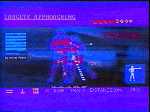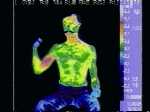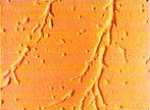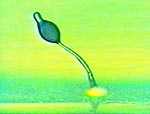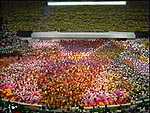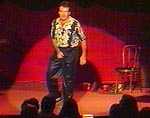NARRATION SCRIPT
KI & THE POWERS OF JAPAN
A Highly Condensed Assembly of Ideas |
|
|
Titles
Images: Weird "Ki Masters" |
|
|
Opening Sequence Images: People/animals gazing, glaring and gaping Prof. Michael Moerman: Pretty simple question really, pretty important one, too, when you think about it, because for most of us, what we look at largely determines the content of our consciousness, our memories and gradually our identities. Not to mention the content of this program. The face that you are now presumably looking at belongs to Michael Moerman, an anthropologist and student of the structures of human communication. I also have the presumed pleasure of entering your minds and memories as your host for the next hour as we explore some quite new and ancient ways of looking at the world, ways of looking that offer unique perspectives on this business we call reality - especially as it is perceived and practiced in Japan.
Images: Anthropologist intro, people bowing, bowing, bowingMM: We would like to direct your attention to some of the greatest enigmas we face today - the mysteries surrounding corporate bodies: how they form and function, why they hold together and why some of them - Japanese corporations, for example - seem so much more aggressive, powerful and, well, evolved than others.
Images: Japanese crowds, factory hordes, slime moldThen we would like offer meditations on the unexpected ways these great social organisms affect our dreams, lives and societies. Why, for example:
Images: Professorial faceAnd... Images: Madonna with cameraman and Warren BeattyAnd... Images: Black comic grabbing crotchAnd... Images: Magic glasses scene from "They Live!" MM: Which brings us back full circle to our opening question and true starting point, "What you are looking at? Or, in slightly more important words, where is your attention? For perhaps the first step in fathoming Ki and the Powers of Japan is learning to perceive ki as the power of attention.
Images: Attention riveting: Burning piano, Suicide bluff, Semen stains, Kids explainingWhat's so important about attention anyway? When you pay attention where does it come from, what does it cost you and what do those who get actually receive? What is attention good for and why do so many of us need it?
Images: Attention getting: flashers, monster cars, muscles, crotch threats, Madonna fellatio, etc. In the West these are suspiciously neglected areas of inquiry, but in Japan they have pondered these questions for many centuries. And they coined many interesting concepts and expressions to answer them. The Chinese gave Japan a big advantage of course. They gave her Ki. Over a millennium ago, when Japanese scholars sailed as students to China, they returned awash with ki. Ki terminology permeated China's medicine, martial arts, meteorology, geomancy and even statecraft. The Chinese did not invent ki of course, anymore than Newton invented gravity. But they were perhaps the first to recognize and name it, and grasp its importance as a guiding, formative force in all levels of being.
Images: Koyanasquatsish cycle from streams to clouds to rain to sea As a working concept, ki dates back at least 22 centuries to the Yellow Emperor's Classic of Internal Medicine, a book which laid out the basic terms and energy relationships that informed oriental medicine (and Confucian politics) up into the present century. In it the mythical sage wrote that the body's ki flows distribute vitality and sensation the way blood distributes our lunch. And he compared the body to a nation or living community in which energy and resources had to be equitably distributed for the health of the whole.
Images: Fat stock broker, rag pickers, street riotHe warned that when certain organs of the community took more than their fair share, other members of the social body would inevitably starve, and cry out in pain for more care, ki and attention. |
|
|
The early Japanese recognized the wisdom and power of these views, and readily adopted acupuncture, moxibustion and all the
other ki technologies of Chinese medicine. But what really fascinated them most about ki was its psychological and social
effects.
Japanese students of ki looked at the world and saw that the streams of directed consciousness that connect each of us to our families, fellows and environment were, in essence, also ki, psycho-social ki if you will, or, as we call it in the West, attention.
Images: Eyes fawning, connecting, surveying They began to track this attentional ki, following its flows between the mind and body, between persons and their surroundings, and between the members of social bodies. And as they explored these living nets of conscious ki, they discovered the three great open secrets of attention: FIrst, attention is nourishing. After light it is probably Nature's most important nutrient - a rich existential fertilizer that feeds creative growth and development wherever it is lavished. Second, attention is healing. It can increase vitality, boost the immune system, even intensify the libido in those who receive it in great measure. Last, but no less important to corporate-minded Japanese, attention is adhesive. It is in fact the psychic glue that bonds families, groups and vast social organisms together. Since all these ki phenomena have quite extraordinary implications for our lives, environment and common future, they deserve more detailed explanations: NARRATION
Images: Kids with miner beams, magnifying glass, family album, honey tongue, lizard snap, ax murderKi o tsukeru, the Japanese say, when you pay out attention and fasten your ki to something. Like a beam of light in the darkness, ki puts parts of the world in contact with your mind and creates a living channel of conscious energy. As an incoming flow, ki "in-fluence" can connect our minds to the small, the distant, the past. It can reach out and capture food for thought - psychic and sensual nourishment - - that is sometimes agreeable - - - and sometimes not.
Images: Terminator vision, Predator clips. Deep Throat Attentional ki streams through our senses so effortlessly we are usually unaware of its comings and goings. But experienced from a slightly altered perspective, ki activities become more obvious. While incoming ki changes the content of consciousness, outgoing ki can change the content of the world.
Section I Title: KI IS NOURISHING Images: Busker gleaning, Bugsy lavishing, Papa nursingWhenever and wherever attention flows, it draws other nutrients in its wake.
Images: Ideagram graphics The character for 'i' combines two older characters - 'on' or sound; and shin, the ideogram for the heart. So "i" is literally a 'sound in the heart'- an inner voice, inspiration, or impulse that provokes action. Depending upon the message and person, 'i' can fade away like a whim, strengthen to a purpose or seethe as an obsession.
Images: Suicide whim, Son/drunk dad rap, Pusher bustBut to take form, 'i' must pour out of the mind and contact the world and i in outward movement provokes the power of ki. Ki was first depicted as the power of the cauldron, of vapor aroused and channeled, the power of directed excitation.
Images: Guitar riffs, Taichi, Muscle-building, Obsessive creationIn the psychic realm, ki is the lush stream of consciousness. Ki flowing toward a goal collects and deposits substance and begins to generate "chi" or structure - either routines, skills and other structured behavior; or true physical structures: muscles, objects, organization. But whatever the arena, the pattern holds i arouses ki, ki nourishes chi. |
|
|
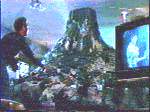 Images: Clips from "Fame," "Personal Best," "Rocky," " "Field of Dreams," "Bugsy" The "i" could be a simple love of music, ki the attention poured into practice and chi the solid mastery of performance. Or "i" could be a hope or an ambition, a quiet voice or a blazing vision And once brought into existance, one level of "chi" can inspire new "i" and further rounds of creation...
Section II Title: KI IS HEALING
Images: Doting parents, Still face experimentAttentional ki not only delivers nutrients, it communicates vital energy. Paying out attention expresses and expends our vitality. It also charges and enlivens individuals who receive it.
Images: Institutionalized child, neurotic monkey babe And ki deprivation can be devastating. As early as the '40s, studies focused attention on the slower development and increased sickliness of institutionalized children. During just a few weeks of hospitalization, this calm and cheerful child became acutely dependent, and then totally exhausted and desolate. This is the face of ki anemia, and it is not just a human phenomenon. It can afflict any unattended young social animal, diminishing its vitality, health and development.
Images: Douglas digs Douglas, ThermochromagraphyYoungsters suffer more from inattention because they spend so little of their ki upon their person. Adults, however, can often recharge themselves. Besides the broadly energizing effects of self-regard or self-esteem, we can focus ki internally, and consciously route heat, nutrients and immune cells to any part of the body.
Images: Drug commercials, Moxibustion/acupuncturePerhaps the most familiar call to inner focus is pain, the body's cry for attention to a weakened or wounded area. While western medicine strives to stifle these cries with pain-killers, Oriental healers closely attend to their messages and draw ki to depleted, endangered areas with warmth and precise stimulation.
Images: Chigung treatments, Johrei session Eastern medicine is energy medicine. Its masters feel the energy body is the template of the physical, and the source of all creative, sexual and immune vitality. They thus work to boost and balance body energy, and have developed many techniques for ki transfusion. Chi gung - literally, the "skill of ki" - is now a licensed specialty in all Chinese hospitals, and in Japan thousands of johrei adepts attentively channel ki to patients battling afflictions of all kinds
Images: Brainwave scans, zazen, prayer, slow sexKi research has revealed that interpersonal flows can harmonize the brain waves of senders and recipients. Focused "ki-nections" entrain the neural firing of both into slow, steady alpha rhythms, the wave pattern of meditation, prayer and quiet, sensuous love. But if one ki donor is good, wouldn't lots be even better? Many cultures seem to have sensed this possibility and independently developed two common techniques of collective healing - mediated transfer and direct induction.
Images: Star healing from "Elmer Gantry" Mediation is the star system. A group charges and illuminates a focal individual, who then discharges the collective ki into a patient. Often without acknowledging its true source.
Images: Balinese ketchak rite, Chigung In the direct style or ki coven, there are no middlemen. Though now often performed as an art, the Balinese ketchak was first a village rite to induce healing or oracle with torrents of focused attention. Primed with hours of chant and yogic breathing, participants pour their ki to the center in rhythmic flares. Sick villagers or sensitive girls then dance through the heart of this psychic furnace until its power cures or possesses them with prophetic trance. But whether healing with force or with delicacy, the circuits of ki bind the people involved and thus create a greater whole.
Section III Title: KI IS ADHESIVE 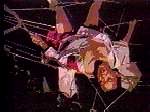
Images: Chains, Indenture, Passion gropes, Indebtedness Many kinds of bonds command our attention - penal bonds, the bonds of indenture and servitude, male bonding, the bonds of friendship, lust, and passion, as well as the social bonds of convention and indebtedness. By far, the most ancient and intense kinection is the mother- child bond, and the reciprocal ki flows are almost visible.
Images: Mother love, Brother battle, Grouper grope, Tough love But however they arise, powerful ki interactions bind people tightly together - as male competitions often noisily suggest.
Images: Rough grapple to loveSexual bonding can also get off on this aggressive foot - until ki flows begin to connect and synchronize.
Images: Kiddie lust, Dance attraction, Petrel love Fortunately, pair bonding usually begins less stormily with sensual interest and attraction, ideally mutual attraction.
Marriage rituals stiffly re-enact this unifying attraction and consecrate it to spawn new diversity. Relations of blood, dependency and proximity open channels of ki flow among family members, tieing them into unique living systems.
Images: Marriages, Families, Clans Although family bonds are strong, and furnish many metaphors for modern corporate life, more informal bodies seem to be the true ancestors of today's great social organisms.
Images: Geese, Wolf pack, Caribou herd, Most animal species only form non-family groups for special purposes - migration, self-defense or the hunt. Before and after these collective efforts, they contentedly dwell apart with their families or simply go it alone.
Images: Whale pull, Expeditions, Rites, Battle, Barn-raising Unrelated humans too once only congregated for efforts requiring special power - exploration, worship, war or construction. For all these tasks, the group fastened its collective ki upon specially skilled masters who orchestrated it for common ends.
Images: Indonesian grave construction, Union rally, Charged eldersTraditional work groups clearly embody the animating power of synchronized ki. For those who head and control these bodies, the feeling of vitality is intoxicating. Basking in focused group ki not only feels good, it confers real authority - the power to subdue, to transfix, to motivate. To turn random spontenaity into synchronized order. But once individuals have experienced the charge of collective ki, the break up of their group often leaves them feeling drained and desolate.
Images: Post-fest leader depression - union, tribal, AmishThe same deflation occurs when any group activity comes to its natural end and its respective leaders sink back into shadow.
Images: Armed attacks, Inquisition burnings, "Dr. Strangelove" How to hold on to the spotlight and maintain the vital flow of ki? Leaders with military and religious skills quickly discovered, they could prolong their command of public attention almost endlessly by kindling chronic fear in the neighborhood. With terrible threats, weapons and ["the international communist conspiracy to sap and impurify all our precious bodily fluids" {Dr. Strangelove}], they continually reinvented their "neededness" and guaranteed that in all future leadership ["it would be absolutely vital that our top government and military men be included to foster and impart the required principles of leadership and tradition. Sieg heil!" {Dr. Strangelove}] and, equally important, that anxious public ki would always be available to nourish the structures that enshrine and protect them. But both armies and churches are at bottom rigid and parasitic bodies. They can rule and order societies, but rarely aid or even tolerate their members' evolution. Productive work groups thus became the focus of human social progress.
Images: Japanese work group segmentSmall work groups were healthy - creative and bonded yet diverse, personal and temporary.
Images: Swarming factories, Huge meetings, Zombie managers, Vast offices Big work groups, however, can quickly expand beyond human scale, values or control. As managers specialize and lose productive skills, they become totally dependent upon the corporate body to feed and protect them. They in turn now must defend the body, and their positions, against all threats, and this requires incessant growth. Corporations thus take on a life of their own, and soon grow too vast and impersonal to focus attention on members' needs or identities. Only those at the top have face - either to lose or attend to. All other individuals are uniformly "effaced" - becoming "workers," and then simply "labor." And fall into shadow forever. To better understand these vast collectivities and why millions submit to their bondage, it helps to consult the ancient ones.
Parable of the Micro-BeastImages: Protozoa on speed, partying, scoringLike our selves at a distance, our protozoan forefathers seem pretty similar, simple and hyper. But viewed with a bit more intimacy, they turn out to be pretty regular guys. They dig hanging out, partying, deep relationships. |
|
|
Images: Protozoan schizophrenics, romance, Feeding frenzy, Slime mold intro  In youth, they too are often pretty mixed up
about what direction to take with their lives. Some become solitary
and meditative, aspiring to higher things. Some just cruise around
looking for love, and finally pair up and start their own
free-wheeling households. And some families go on to become stable
dynastic clans.
In youth, they too are often pretty mixed up
about what direction to take with their lives. Some become solitary
and meditative, aspiring to higher things. Some just cruise around
looking for love, and finally pair up and start their own
free-wheeling households. And some families go on to become stable
dynastic clans.
Music: "Summertime" by Janice JoplinBut some, like these Myxomycetes, seem to prefer fast living and the joys of high consumption. When they have devoured everything in the environment, however, they too grow quite anxious and insecure.
Music: "We Gotta Get Outta this Place" by the AnimalsThey race around, looking for leaders, trying to find their way back to the good times in movements, trends, or ryuko, as the Japanese call them - 'flow-alongs'.
Music: "Just a Closer Walk with Thee"Like early humans, they converge to gain special powers, and hundreds of thousands of individuals may join bodies pledging protection and deliverance. Among the myxomycetes these corporate bodies are called grexes and they are true to their word. Although grexes lack nerves, veins or any other internal structures, synchronized ki flows animate these bodies with extraordinary grace and esprits du corps. While incorporated, most members have few responsibilities beyond obedience and self-synchronization, and they soon lose the need or ability to decide anything for themselves.
Images: Grex balletsThis second childhood is only a brief transition, however, and prepares them for resurrection in a final act called "fruition."
Images: Grex migration and fruition When a grex finally senses greener pastures it hunkers down and sends its membership aloft in a blossom of cocoon-like spores. The incorporated brothers then break out, ride the wind, and awaken again in new situations as free individuals.
Images: Spore liberation and rebirthPerhaps the most striking aspect of grex corporate behavior is the altruism of its executive class - here dyed a distinctive red.
Images: Dyed executive cells, fruition, ascent of spore case Unlike their passive followers, grex managers are movers and shakers. They drive themselves furiously - conferencing, writing molecular memos, generating constructive consensus. Their decisions totally control the corporate mission, but once it is fulfilled, they gallantly yield all the escape craft to their child-like charges. The executives all stay behind in the base, stalk and empty cradle of their brethren's rebirth.
Images: Grex rampant But what if grex managers weren't quite so noble? After all, why relinquish power? Why break up such an enormously good thing? Why not perpetuate it like a church or army, and make the collective enterprise not a means, but an end in itself?
Images: Tribal beauty show, Koyanosquatsi crowd and traffic flowsThe metaphor is not strained. While humans have evolved infinitely richer individuality than ancestral amoeba, our collective behaviors have progressed little. From certain angles, the ki flows of the body politic still appear quite fluid, organic, and primal.
Images: Swarming Soka Gakkai convention, Hierarchic acrobatics The collective instincts abide. Vast gatherings continue to excite us, to exercise synchronized power, develop routines, and finally to generate structure and hierarchies. We are obviously still drawn to these assemblies for amusement, protection or special occasions. But the mystery remains why some of us so willingly surrender our individuality to them as a permanent life condition.
KI BONDING
Images: Flag raising, Crotch/heart/head chakras  In the East, we noted, the body is not considered a thing, but a spire of energy, with three ki centers: the sexual or lower chakras, the central heart chakras and the cerebral upper chakras.
Lower Chakra Bonds Images: Sexual bonds, family groups Lower chakra bonds are personal, intimate, and equitable. Their hormone nourishing ki flows feed genetic, familial structures as well as courage, will and curiosity.
Images: Testosterone transformations, crotch regards
Images: Love muckles, Sexual energy bonds  Sensual ki and hormones embolden the claims of the self, and their
ancient bonds have little respect for outside authority. Fired by love or tantric
practice, mutual ki intercourse can even grow numinous, fusing
individuals into a single soaring energy body.
Sensual ki and hormones embolden the claims of the self, and their
ancient bonds have little respect for outside authority. Fired by love or tantric
practice, mutual ki intercourse can even grow numinous, fusing
individuals into a single soaring energy body. Images: Basic training ordeals, ball busting - complex and crudeSocial body builders must break these bonds at their source to free up ki for corporate calling. Their modern weapons are acute and chronic stress which produce estrogen-like molecules that quench male hormones and cockiness. But when all else fails, there are always the old ways, to prepare men for corporate function.
Heart Chakra Bonds Images: Music groups, Sports teams, Gorilla band, Gangs, Environmental attention Ki flows from the heart chakras conjoin people in sympathy, compassion and close cooperation, and are thus also quite equal. They unite individuals into teams, bands and fellowships - as well as emotionally connecting them to the world of nature.
Upper Chakra Bonds Images: Limp salute, Company women bowing to TV, Flag salutes, Police/military phalanxes Upper chakra bonds, however, are purely mental attachments. These ties of duty and allegiance can siphon off ki to distant unifying symbols, and thus grow very impersonal and unequal. They therefore can also unite monstrous organizations with little regard for members' identities or environments.
Images: Individual attention scenes, Team bondingEqual bonds are those that distribute attentional ki evenly within a relationship. Reciprocal ties of love, friendship and mutual respect nurture both individuality and a natural sense of community. But since equal bonds derive their strength from intimate contact, they cannot bind large groups over time.
Images: Bridge dangle, Cool Hand Luke breakdown, Ecclesiastic homage, Naked threatIn inequal bonds - such as those generated by debt, fear or fealty - certain persons continuously pay more ki into the relationship than they receive. Some members therefore always command a ki surplus, while others endure chronic deficits.
Images: Hierarchy tableaux from church, court, Forbidden City eunuchs, Salariman assembly Under pressure, unequal flows gradually solidify into hierarchal systems. Lower ranking members instinctively submit and channel their attention to group leaders and purposes. And as submission becomes second-nature: E pluribus unum - Out of the ki of many, One...
Words: "Gung Ho" Manager: "We must build spirit. We must be a team with one purpose only - everyone thinking only of company."But for this new "One" to persist and prosper, it must continue to dominate its members' attention, and therefore retard their growth as individuals.
Images: Mass production lines, Group wave effects, Frenzied productionAttentional ki is the binding, animating protoplasm of the social organism. The less members claim for their persons, or leak to affairs outside the collective membrane, the more ki there is to quicken the corporate body.
Images: Japanese executive discipline classesSince independent values, sensuality or a sense of personal rights all distract ki from collective esprit de corps, the best members are the most docile and child-like. In Japan, therefore, the ideal worker is a hanninmae or eien kobun - literally, an "unfinished man" or "perpetual child- figure."
Images: "Last Emperor": Gauze cloud eunuch game, Ghostly trading floorIn corporate anthroculture, the term is "homuncell" - a diminished man who quietly performs the cellular roles of the social body. Like all good cells, homuncells are dependent, anonymous and sexually indistinct. They are the totally incorporated, those who have fused their fate, minds, and identities with the corporate body.
Images: Salariman collage  Japan's homuncell archetype is the so-called salariman,
a neotenous white collar worker, with weak family bonds, few
assertive hormones, and little time for either nature or society.
Salariman/homuncells generally channel two thirds of their daily ki
to corporate function, and redefine their own growth in terms of
fashions, games and consumption.
Japan's homuncell archetype is the so-called salariman,
a neotenous white collar worker, with weak family bonds, few
assertive hormones, and little time for either nature or society.
Salariman/homuncells generally channel two thirds of their daily ki
to corporate function, and redefine their own growth in terms of
fashions, games and consumption. Although salarimen are individually unimpressive, and constitute less than 20% of the nation's workforce, their aggressive corporate bodies dominate Japan's politics, media and education, as well as the world economy.
Images: Disorderly school babes -> Regimentation in class and companyThe task of modern anthroculture is thus quite simple - how to prepare human minds and bodies for perfect incorporation - how to simplify this, to this, to this without destroying useful forms of intelligence.
Images: Soviet Young Pioneers street marches, Baseball East & WestThanks to Soviet corporate body builders ["we know now that 8- to 14-year-olds fear humiliation almost as much as the possible death of a parent."] in light of which we might consider how certain children are taught baseball. For these kids, team sports are "played," and they learn how to compete and cooperate without losing individuality. For Japanese children, teams are serious and stressful business, that teach them their place, and train them to obediently channel their ki to the authorities directing their lives.
Words: "It matters how you play the game. Winning and losing are all-important A bad play has consequences. (Knock in head) It all depends on the cues children receive, the models they see."Although other modern societies now invest heavily in homuncell development, Japanese corporate anthroculture still enjoys a few peculiar advantages:
Images: Reflexively prostrating subjects, soldiers, wenches
Images: Cram school scenes
Images: Lancet article
Images: Ambivalent mom
Images: Slime mold cityscapes, Juvenile porno, Cement ecology, Women's street marches, Asian slums, Clear-cut forestsJapan's massive diversion of personal ki to corporate goals has repercussions, however: falling birth rates, violent and juvenile sexuality, environmental loss, and the near total feminization of civil society - not to mention a brutal disregard of peoples and problems outside the corporate membrane.
Images: Koyanasquatsish crowd scenes, Superman breakouts, Craft work, Family scenesBut what if homuncells are only temporarily arrested? What if the bodies they entered to escape post-war poverty, were to finally call the mission complete? What if our corporate grexes were now to fruit, and liberate the salarimen and their ki for a grand new round of adulthood and re-evolution? What if???
End of Narrated Insert
Michael Moerman: I guess the basic message is "Ki ni ki o tsukete." Start paying
attention to attention, or watch where you fasten your ki. It makes a difference.
"How many minutes of ki do you spend each day on your most intimate surroundings - your body, family, neighborhood? How many go to your company or work? How many are given to society's problems, spiritual concerns or spent on behalf of the planet?
And how many just go down this tube?
Ki sluiced into the TV is not totally lost, by the way.
At any rate, we hope that this brief and highly unauthorized
introduction has offered at least a glimpse of what attentional ki
is, how it works and why it's important to watch where it goes.
As I trust our opening disclaimer makes clear, this presentation is
intended only for potential allies and investors -
that is, for all those concerned with these ideas and willing to help develop and
popularize them.
We're looking now at educational videos, children's books, CDROMs and
computer games. What are you looking at?
Conclusion
Concept & BricolageW. David KubiakNarrationMichael MoermanKathy Arlyn Sokol Tech-Spirit SupportChristopher FrymanSlime Mold PhotographyDr. Takizo YamadaKi & Cover GraphicsBruce BattoeSpecial ThanksJohn Perry BarlowCarl Becker Joey Ito Harry Quini Howard Rheingold Emiko Sugita The Elmwood Illuminati The Kidd/Morimoto Conspiracy
ProductionHeaven on Earth ProductionsKyoto Ecomedia Institute
Words: John Allen: "Because there are many forces that prefer to keep ignorance as a state of humanity." The End (for now...) Order Information
This production is a preliminary development outline intended to attract support to secure the rights for a full exploration of this subject. It obviously cannot be sold or rented in its current form, and is designed only for demonstration purposes. If you would like to help develop and propagate these ideas, please contact W. David Kubiak at wdkubiak(at)gmail.com. Main Archive |

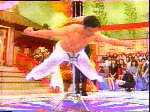

 Their ancient ideogram for ki depicts an invisible force lifting the
lid of a heated vessel. Ki was not merely random energy it was a
moving force with pattern, direction, duration. In life ki expressed
itself in flows of semi-sentient power that rivered through the
biosphere, our bodies, and all living processes. And the Chinese,
you must remember, saw life in places we are only now beginning to appreciate:
Their ancient ideogram for ki depicts an invisible force lifting the
lid of a heated vessel. Ki was not merely random energy it was a
moving force with pattern, direction, duration. In life ki expressed
itself in flows of semi-sentient power that rivered through the
biosphere, our bodies, and all living processes. And the Chinese,
you must remember, saw life in places we are only now beginning to appreciate: 

